Purchasing Managers Index for October 2022
Department of Service Statistics of NBS
China Federation of Logistics and Purchasing(CFLP)
1. Manufacturing Purchasing Managers Index
In October, the Purchasing Manager Index (PMI) of China's manufacturing industry was 49.2 percent, decrease 0.9 percentage points from the previous month, below the threshold.
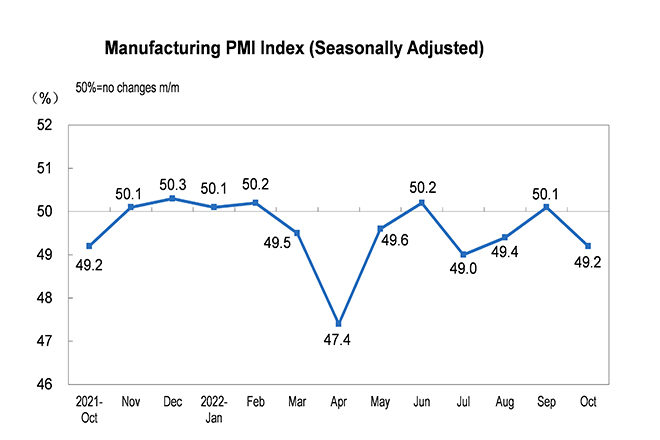
In terms of enterprise size, the PMI of large enterprises was 50.1 percent, decrease 1.0 percentage points from the previous month, still higher than the threshold; the PMI of medium-sized and small enterprises was 48.9 and 48.2 percent respectively, decrease 0.8 and 0.1 percentage points from the previous month, still below the threshold.
From the sub-indexes, the five sub-indexes that constitute the manufacturing PMI were all lower than the threshold.
The production index was 49.6 percent, decrease 1.9 percentage points from the previous month, indicating that manufacturing production activities have fallen.
The new order index was 48.1 percent, decrease 1.7 percentage points from the previous month, indicating that the market demand of the manufacturing industry continued to decline.
The raw material inventory index was 47.7 percent, increase 0.1 percentage point from the previous month, indicating that the inventory of major raw materials in the manufacturing industry was in slightly narrowed decline.
The employment index was 48.3 percent, decrease 0.7 percentage point from the previous month, indicating a decline in the employment outlook of manufacturing enterprises.
The supplier delivery time index was 47.1 percent, decrease 1.6 percentage points from the previous month, indicating that the delivery time of raw material suppliers in the manufacturing industry continued to slow down.
China's Manufacturing PMI (Seasonally Adjusted)
|
Unit: % |
||||||
|
|
PMI |
|
||||
|
Production Index |
New Orders Index |
Raw Materials Inventory Index |
Employment Index |
Supplier Delivery Time Index |
||
|
2021-October |
49.2 |
48.4 |
48.8 |
47.0 |
48.8 |
46.7 |
|
November |
50.1 |
52.0 |
49.4 |
47.7 |
48.9 |
48.2 |
|
December |
50.3 |
51.4 |
49.7 |
49.2 |
49.1 |
48.3 |
|
2022-January |
50.1 |
50.9 |
49.3 |
49.1 |
48.9 |
47.6 |
|
February |
50.2 |
50.4 |
50.7 |
48.1 |
49.2 |
48.2 |
|
March |
49.5 |
49.5 |
48.8 |
47.3 |
48.6 |
46.5 |
|
April |
47.4 |
44.4 |
42.6 |
46.5 |
47.2 |
37.2 |
|
May |
49.6 |
49.7 |
48.2 |
47.9 |
47.6 |
44.1 |
|
June |
50.2 |
52.8 |
50.4 |
48.1 |
48.7 |
51.3 |
|
July |
49.0 |
49.8 |
48.5 |
47.9 |
48.6 |
50.1 |
|
August |
49.4 |
49.8 |
49.2 |
48.0 |
48.9 |
49.5 |
|
September |
50.1 |
51.5 |
49.8 |
47.6 |
49.0 |
48.7 |
|
October |
49.2 |
49.6 |
48.1 |
47.7 |
48.3 |
47.1 |
Related Indicators of China's Manufacturing PMI (Seasonally Adjusted)
|
Unit: % |
||||||||
|
|
New Export Orders Index |
Import Index |
Purchase Quantity Index |
Main Raw Material Purchase Price Index |
Producer Price Index |
Finished Goods Inventory Index |
Open Orders Index |
Production And Business Activities Expectation Index |
|
2021-October |
46.6 |
47.5 |
48.9 |
72.1 |
61.1 |
46.3 |
45.0 |
53.6 |
|
November |
48.5 |
48.1 |
50.2 |
52.9 |
48.9 |
47.9 |
45.7 |
53.8 |
|
December |
48.1 |
48.2 |
50.8 |
48.1 |
45.5 |
48.5 |
45.6 |
54.3 |
|
2022-January |
48.4 |
47.2 |
50.2 |
56.4 |
50.9 |
48.0 |
45.8 |
57.5 |
|
February |
49.0 |
48.6 |
50.9 |
60.0 |
54.1 |
47.3 |
45.2 |
58.7 |
|
March |
47.2 |
46.9 |
48.7 |
66.1 |
56.7 |
48.9 |
46.1 |
55.7 |
|
April |
41.6 |
42.9 |
43.5 |
64.2 |
54.4 |
50.3 |
46.0 |
53.3 |
|
May |
46.2 |
45.1 |
48.4 |
55.8 |
49.5 |
49.3 |
45.0 |
53.9 |
|
June |
49.5 |
49.2 |
51.1 |
52.0 |
46.3 |
48.6 |
44.2 |
55.2 |
|
July |
47.4 |
46.9 |
48.9 |
40.4 |
40.1 |
48.0 |
42.6 |
52.0 |
|
August |
48.1 |
47.8 |
49.2 |
44.3 |
44.5 |
45.2 |
43.1 |
52.3 |
|
September |
47.0 |
48.1 |
50.2 |
51.3 |
47.1 |
47.3 |
44.1 |
53.4 |
|
October |
47.6 |
47.9 |
49.3 |
53.3 |
48.7 |
48.0 |
43.9 |
52.6 |
2. Non-manufacturing Purchasing Managers index
In October, the non-manufacturing business activity index was 48.7 percent, decrease 1.9 percentage point from the previous month, below the threshold.
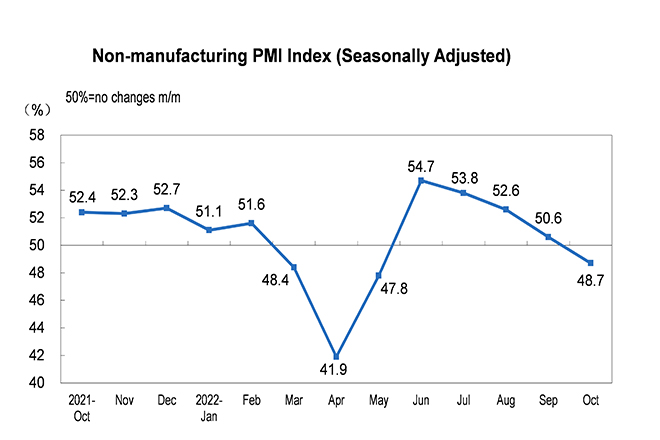
By industry, the business activity index of the construction industry was 58.2 percent, decrease 2.0 percentage points from the previous month. The business activity index of the service industry was 47.0 percent, decrease 1.9 percentage points from the previous month. From the perspective of the industry, the business activity index of sea transport, telecommunications, radio and television and satellite transmission services and monetary and financial services was in the higher boom range of more than 55.0 percent; The business activity index of retailing, road transport, air transportation, accommodation, catering and leasing and business services was lower than 45.0 percent.
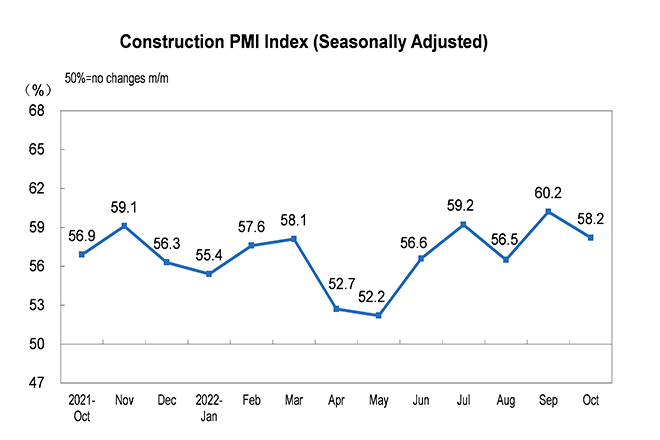
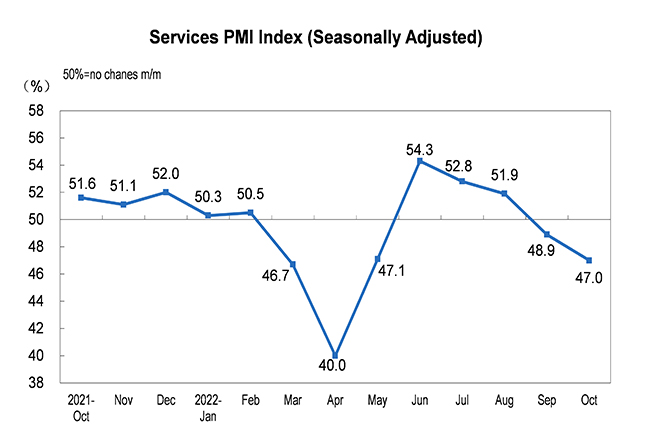
The new order index was 42.8 percent, decrease 0.3 percentage points from the previous month, falling below the threshold, indicating a continuous slowdown in non-manufacturing market demand. By industry, the new order index of the construction industry was 48.9 percent, decrease 2.9 percentage point from the previous month; the index of new orders in the service industry was 41.7 percent, increase 0.1 percentage points from the previous month.
The input price index was 51.0 percent, increase 1.0 percentage points from the previous month and higher than the threshold, indicating that the overall level of input prices used by non-manufacturing enterprises for business activities has increased. By industry, the construction industry input price index was 52.3 percent, decrease 0.1 percentage points from the previous month; the price index of service industry inputs was 50.8 percent, increase 1.2 percentage points from the previous month.
The sales price index was 48.1 percent, decrease 0.1 percentage points from the previous month, falling below the threshold, indicating that the overall non-manufacturing sales prices continued to decrease. By industry, the sales price index of the construction industry was 49.8 percent, decrease 2.2 percentage point from the previous month; the sales price index of the service industry was 47.8 percent, increase 0.3 percentage points from the previous month.
The employment index was 46.1 percent, decrease 0.5 percentage point from the previous month, indicating that the employment outlook of non-manufacturing enterprises continued to fall. In terms of industries, the construction industry employee index was 47.8 percent, decrease 0.5 percentage point from the previous month; the index of service industry employees was 45.8 percent, decrease 0.5 percentage points from the previous month.
The expected index of business activities was 57.9 percent, increase 0.8 percentage points from the previous month, higher than the threshold, indicating that non-manufacturing enterprises have increased confidence about the recent market recovery and development. By industry, the expected index of business activities in the construction industry was 64.2 percent, increase 1.5 percentage points from the previous month; the expected index of business activities in the service industry was 56.7 percent, increase 0.6 percentage points from the previous month.
Main Indices of China's Non-manufacturing PMI (Seasonally Adjusted)
|
Unit: % |
||||||
|
|
Business Activity Index |
New Orders Index |
Input Price Index |
Sales Price Index |
Employment Index |
Business Activities Expectation Index |
|
2021-October |
52.4 |
49.0 |
57.8 |
52.7 |
47.5 |
58.8 |
|
November |
52.3 |
48.9 |
50.8 |
50.1 |
47.3 |
58.2 |
|
December |
52.7 |
48.4 |
49.3 |
48.1 |
47.6 |
57.3 |
|
2022-January |
51.1 |
47.8 |
52.1 |
51.0 |
46.9 |
57.9 |
|
February |
51.6 |
47.6 |
53.9 |
49.8 |
48.0 |
60.5 |
|
March |
48.4 |
45.7 |
55.9 |
51.1 |
47.1 |
54.6 |
|
April |
41.9 |
37.4 |
53.7 |
48.9 |
45.4 |
53.6 |
|
May |
47.8 |
44.1 |
52.5 |
49.4 |
45.3 |
55.6 |
|
June |
54.7 |
53.2 |
52.6 |
49.6 |
46.9 |
61.3 |
|
July |
53.8 |
49.7 |
48.6 |
47.4 |
46.7 |
59.1 |
|
August |
52.6 |
49.8 |
50.0 |
47.6 |
46.8 |
58.4 |
|
September |
50.6 |
43.1 |
50.0 |
48.2 |
46.6 |
57.1 |
|
October |
48.7 |
42.8 |
51.0 |
48.1 |
46.1 |
57.9 |
Other Indices of China's Non-manufacturing PMI (Seasonally Adjusted)
|
Unit: % |
||||
|
|
Foreign New Orders Index |
Open Orders Index |
Stock Index |
Supplier Delivery Time Index |
|
2021-October |
47.5 |
44.3 |
45.5 |
49.7 |
|
November |
47.5 |
43.9 |
45.6 |
50.1 |
|
December |
47.7 |
43.4 |
46.4 |
49.6 |
|
2022-January |
46.0 |
43.9 |
47.0 |
49.2 |
|
February |
48.1 |
44.1 |
46.6 |
49.8 |
|
March |
45.8 |
42.8 |
45.9 |
45.2 |
|
April |
42.7 |
41.2 |
43.9 |
42.8 |
|
May |
42.8 |
43.2 |
45.2 |
45.3 |
|
June |
50.1 |
44.5 |
46.8 |
50.8 |
|
July |
45.1 |
43.4 |
47.1 |
50.7 |
|
August |
48.9 |
43.9 |
46.6 |
49.7 |
|
September |
46.0 |
41.7 |
45.3 |
48.7 |
|
October |
45.0 |
43.1 |
45.7 |
48.3 |
3. Composite PMI Output Index
In October, the comprehensive PMI output index was 49.0 percent, decrease 1.9 percentage points from the previous month, falling below the threshold, indicating that the overall production and operation of Chinese enterprises have slowed down.
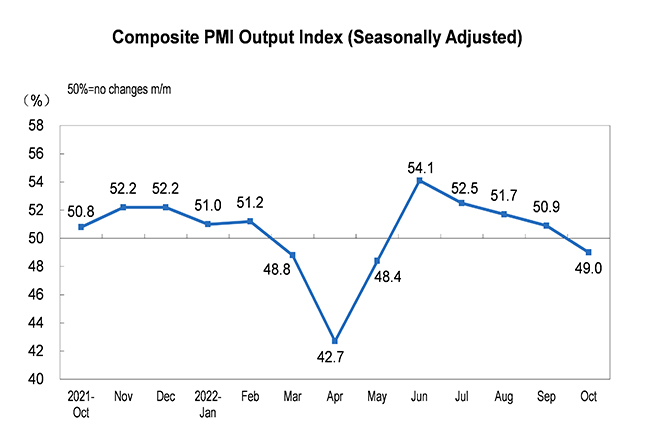
Annotations:
1. Explanatory Notes
Purchasing Managers Index (PMI) is an index summarized and compiled through the results of the monthly survey of enterprises purchasing managers. It covers every links of the enterprises, including purchasing, production, logistics, and so on. It is one of the leading indices which was commonly adopted by international society to monitor the macroeconomic trends, and played an important role in forecasting and monitoring. The Composite PMI Output Index, belonging to the PMI indicator system, is a composite index reflecting the changes in the output in current period of the entire industry (manufacturing and non-manufacturing industries). If PMI above 50 percent, it reflects the overall economy is expanding; if less than 50 percent, it reflects the overall economy is in recession.
2. Statistical Coverage
The survey involves 31 divisions of manufacturing industry in the “Industrial Classification for National Economic Activities” (GB/T4754-2017), and 3200 samples, as well as 43 divisions of non-manufacturing industry, and 4300 samples.
3. Survey Methods
PPS (Probability Proportional to Size) sampling method was adopted in purchasing managers’ survey. Using the divisions of the manufacturing or non-manufacturing industry as the selecting strata, the sample size of each division is proportional to its proportion of the value-added of the division to the total value-added of the manufacturing or non-manufacturing industry. Within the stratum, the samples are selected according to the probabilities proportional to their principal business revenues of the enterprises.
The survey was organized and conducted by staff members of survey offices, monthly through Online Reporting System of NBS by sending survey questionnaires to the purchasing managers of the selected enterprises.
4. Calculation Methods
(1) Calculation Methods of Sub-indices. The indicator system of manufacturing purchasing managers’ survey covers 13 sub-indices such as production, new orders, export orders, existing orders, finished goods inventory, purchase, import, purchase price, producer price, raw materials inventory, employees, suppliers, delivery time, production and business activities expectation. The indicator system of non-manufacturing purchasing managers’ survey covers 10 sub-indices such as business activities, new orders, new export orders, existing orders, finished goods inventory, intermediate input price, subscription price, employees, supplier’s delivery time, and business activities expectation. Sub-indices adopt diffusion index calculation method, i.e. percentage of positive answers in number of enterprises plus half of the percentage in the same answers. Due to the lack of synthesis of non-manufacturing integrated PMI index, the international society often used business activity index to reflect the overall changes in non-manufacturing economic development.
(2) Calculation Methods of Manufacturing PMI. Manufacturing PMI was calculated according to five diffusion indices (group indices) and their weights. 5 group indices and their weights are determined in accordance with their leading impact on the economy. Specifically, new orders index weighted 30 percent; production index weighted 25 percent; employee’s index weighted 20 percent; supplier delivery time index weighted 15 percent; raw materials inventory index weighted 10 percent. Of which, the supplier delivery time index is a converse index, and contrary calculation is needed when combines it into PMI.
(3) Calculation Methods of Composite PMI Output Index. Composite PMI Output Index was calculated by weighted summation of the manufacturing output index and non-manufacturing business activity index. Their weights are determined by the proportion manufacturing and non-manufacturing industries in GDP.
5. Seasonal adjustment
The purchasing managers’ survey is a monthly survey, the data of the survey fluctuates very much for the influences of seasonal factors. The released PMI composite index and sub-indices are seasonally adjusted data.
